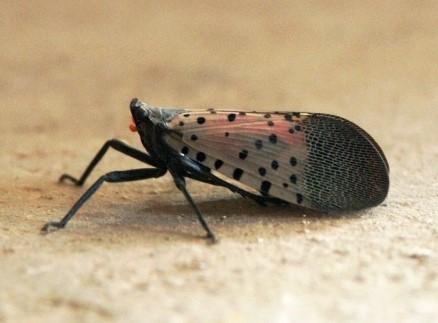Lycorma delicatula
Spotted Lanternfly
Synonyms: Aphaena delicatula
Class: Insecta
Order: Hemiptera
Family: Fulgoridae

Photographer: Henripekka Kallio
Source: Wikimedia Commons
Adult Description: The adult spotted laternfly, Lycorma delicatula, is a small but conspicuous insect with black spots on grayish forewings, and pinkish-red hindwings with black spots and thick striping. They have piercing mouthparts that allow them to feed on the phloem of plants. Symptoms of an infestation are; weeping wounds filled with sap and large amounts of “honey dew” (insect waste) will gather at the base of the tree and blacken the soil. Wasps, hornets and bees are known to feed on the “honey dew”; therefore, another sign of an infestation is increased activity of these insects around the infested tree. Due to the sugar content of the “honey dew”, large infestations can produce mats of fungus and mold at the tree base which can hinder growth or kill the tree.
Larvae Description: Despite the nymphs being quite small they are also very noticeable. They undergo several molts (instars) until they become adults. First instars are black with white dots present all over and as it grows red patches start to develop. They can be found sucking the phloem out of plants like the adults.
Ecological Threat: Even though it has just been found in the United States, it has demonstrated its ecological impact in Korea, where it is also invasive. Over there it has been documented to attack 25 plant species that also grow in the United States. It has the potential to impact the logging, fruit tree and grape industries, which in Pennsylvania alone gross up to $190.5 million dollars.
Biology: In late September through November eggs are laid. Adults will oviposit on any smooth trunk tree, stones, bricks, or any vertical smooth surface including anything that is stored outside for long periods of time like farm equipment. Nymphs are present on the plants during the spring, and going through several instars until they become adults.
Host Preferences: Walnut, Apple, Pine, Poplar, Plum, Peach, Apricot, Cherry, Oak trees, wild grape vines and up to 70 other species!
History: The history of this insect in the United States is very short because it was just discovered in Pennsylvania. The Pennsylvania Department of Agriculture (PDA) in cooperation with the Pennsylvania Game Commission, confirmed the presence at several different collection points. This small pest was found on the invasive Tree of Heaven, wild grape vines and in residential and commercial property. Within the commercial property there is a stone specialty business that imports shipments from China and India which the spotted laternfly is native to.
U.S. Habitat: Found on the Tree of Heaven in Pennsylvania, but was also found in commercial and residential areas.
Distribution
Native Origin: China, India, Japan and Vietnam
U.S. Present: Berks County, Pennsylvania (September 2014)
Management
Since this laternfly has been caught very early in its establishment period; there might be a chance for eradication. Currently the PDA has issued a quarantine for several townships in Berks, County. Also, they have posted methods on how to take care of different lifecycle stages of this bug. For eggs, scrape them off the surface that you see them on, double bag them and then throw them in the trash or place them in alcohol/hand sanitizer to kill them. Adults are better managed by insecticides; ones that are effective against them are Neonicotinoids, pyrethrins, and organophosphates. For a more a more natural means of control, Adults and 2nd-4th instar nymphs seem to be attracted to spearmint oil. Also, in Korea studies have shown that placing sticky traps at the tree trunk can manage infestation populations.
In Pennsylvania, if you are able to collect a specimen turn it into the PDA’s Entomology Lab and submit all photographs to Badbug@pa.gov.
Text References
Moon. S.-R., S.-R. Cho, J.-W. Jeong, Y.-H. Shin, J.-O. Yang, K.-S. Ahn, C. Yoon, and G.H. Kim. 2011. Attraction response of spot clothing wax cicada, Lycorma delicatula (Hemiptera: Fulgoridae) to spearmint oil. Korean Soc. Appl. Biol. Chem. 54: 558-567.
Internet Sources
http://bugguide.net/node/view/1016519
http://ucanr.edu/blogs/blogcore/postdetail.cfm?postnum=15861
 Texas Invasive Species Institute
Texas Invasive Species Institute